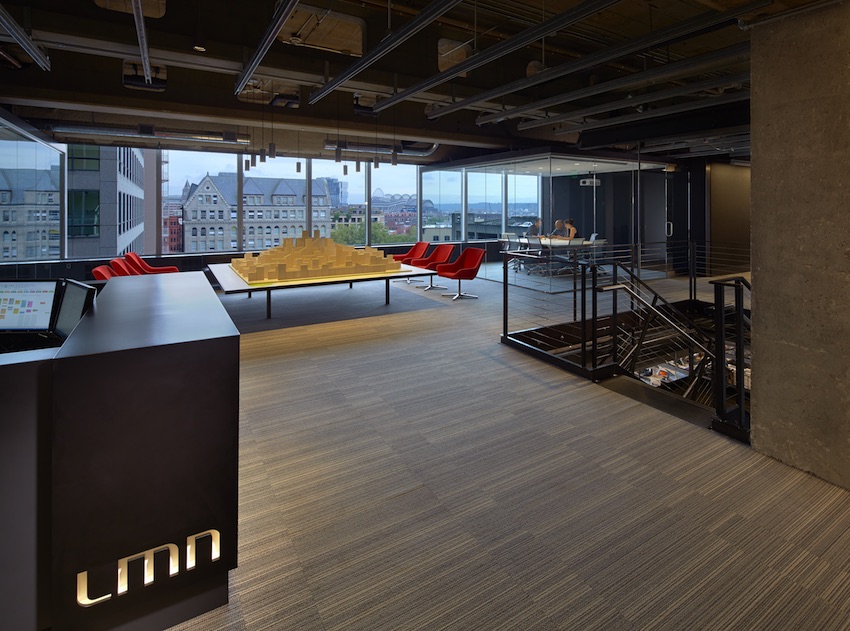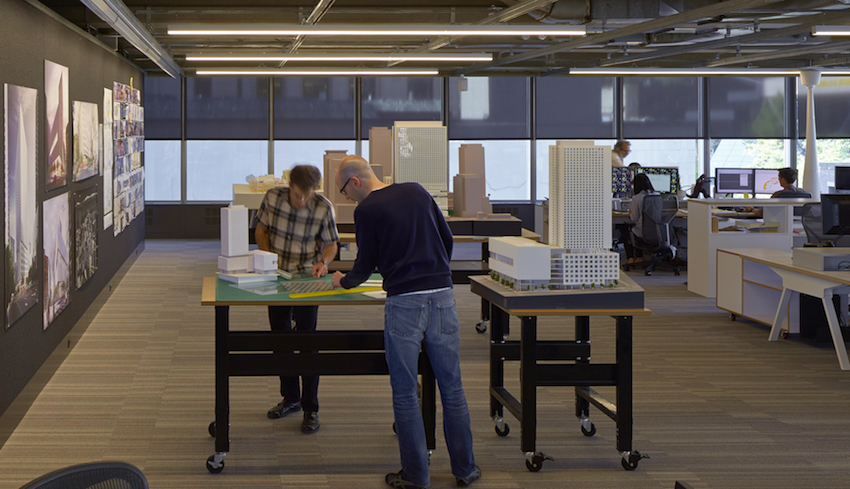Daylight Autonomy 101
A new approach to design. The daylight autonomy of a building is affected by variables of the building envelope as well as the interior layout and furnishings. “One of the challenges in achieving daylight autonomy is that it requires the design team to consider how the massing, siting, and orientation of the building impact the availability of daylight in the interior floorplate,” explains Bailey. It also requires that many of the elements of the interior space be reconsidered in terms of how it affects daylight penetration and daylight management. This includes the layout of the interior space, the placement and selection of cubicle walls, and even the interior color and finish.
Evaluating alternative designs requires a specialist. Perhaps the greatest challenge for early adopters trying to achieve daylight autonomy is the complexity of the software programs currently available to help designers evaluate the DA factors of their various concepts. “The complex software often requires that a lighting designer with a specialized knowledge of these programs be included in the design team. The need for this specialized expertise is one of the factors currently limiting the inclusion of daylight autonomy in many of the building codes or wider adoption of this metric in green building programs, because it does not seem reasonable to mandate that a professional with this capability be required on every project, regardless of scale,” says Bailey. “I'm confident that a more out-of-the-box software solution will be available soon, but it's just not there yet.”
Designing to Achieve Daylight Autonomy
The daylight autonomy a building can achieve is affected by so many variables, it is critically important that the goal of daylight autonomy be identified and actively considered as early in the project as possible. Decisions about the shape and position of the building, interior layout, furnishings, and type of daylight management system specified are all critical components in the amount and penetration of usable daylight that is ultimately found in a building throughout a year.
Building Envelope
Many designers begin creating the conceptual design for a building by considering the general shape and mass the building will have, also known as massing, selecting the location on the site that the building will occupy, referred to as siting, and determining how the building will be oriented on the site in relation to the sun.
The initial decisions made with regard to the massing, siting, and orientation of the building all dramatically impact the type of daylight that is available to the project and the potential access that daylight will have to the interior space. For example, the deeper the floorplate of the building, the more challenging it becomes to achieve target levels of daylight illumination in the more central spaces. In terms of orientation, in the northern hemisphere, it is generally accepted that northern exposures offer the best access to glare-free, ambient light throughout the day, whereas eastern exposures are often subjected to intense and glare-causing daylight as the sun rises, and western exposures experience direct sunlight exposure as the sun sets.

Photo: © Doug Scott Photography 2015
The interior and furnishings of an interior also affect the ability of daylight to travel deeper into the space.
Interior Layout and Furnishings
“Interior space planning is another opportunity to optimize daylight autonomy, especially in office space,” explains Bailey. “Designing private offices with solid walls around the perimeter of the building used to be common practice, but that approach blocked daylight from penetrating deeper into the building. To improve the daylight autonomy of an office building, private offices are strategically placed in more central locations and equipped with glass office fronts, to provide occupants with access to daylight and views,” he adds. Designing a circulation space around the perimeter of an open office area is another way to improve the potential daylight autonomy of the space, by creating a buffer zone to help limit the potential of glare on the workplane. Lighter colors and lower cubicle walls are two examples of interior furnishings that are often specified to help daylight reach deeper into the space.
The Need for Daylight Management
Achieving daylight autonomy requires more than filling a space with daylight, it must be filled with “usable daylight.” As a reminder, usable daylight is defined as daylight within the range of 10 fc and 200 fc that will not disrupt the visual environment or cause glare or hot spots in a space. This range of usable daylight represents a pretty select segment of the daylight that could be available at the window of a building throughout the year, especially considering that daylight can range from a few footcandles on a cloudy day to over 8,000 footcandles on a bright, sunny day. Intense daylight exposure can trim away the usable space in a building by making areas too bright, too glaring, or too hot to use for parts of the day. Avoid the potential pitfalls of daylight exposure by equipping a building to manage the daylight as it enters the space and protect the interior from the bright, direct daylight that can destroy the visual environment and undermine the daylight autonomy of the space.
Here's an example of how a space may be negatively affected if it does not have a way to manage the daylight streaming in through the windows. Consider a section of an open office bay, positioned on the perimeter of the building where one wall is completely exposed to direct daylight.
On a sunny day, the daylight level may reach up to, or over, 8,000 footcandles at its most intense. Today, glass used in Class A office space may have a visual transmittance value (or Tv) of 0.65, which indicates that 35 percent of the available footcandles are reflected back out into the atmosphere and 65 percent of the visible energy is transmitted through the glass and into the building. In this case, 5,200 fc of the 8,000 fc of daylight would enter the open office space, well outside the range of usable daylight.
This scenario was simulated to evaluate the percentage of working hours where the presence of daylight exceeded the usable range of 200 fc on a sunny day. The simulated open office space is 30 feet by 30 feet, the windows are 8 feet tall and the working hours were defined as 8 a.m to 6 p.m. The simulation used real NYC climate data and assumes that no immediate surrounding buildings are present that would cast shadows onto the facade. The DA plots illustrate the percentage of time, during those predefined working hours, that the anticipated daylight level will exceed 200 fc.

Photo: © Doug Scott Photography 2015
The office of LMN Architects in Seattle was designed to maximize the presence of natural light in its workspace while maintaining employee comfort and saving energy.
The results were shocking. Without any way to manage the available daylight beyond the glass, portions of the office space were too bright to occupy comfortably throughout the entire workday. Even more surprising was that in the examples with eastern, southern and western exposures, over half of the office space was uncomfortably bright for over 50 percent of the workday. In the open office area with northern exposure, nearly a third of the office space would be potentially uncomfortable for half of the working hours. That is a significant amount of usable square footage to lose on a sunny day.









